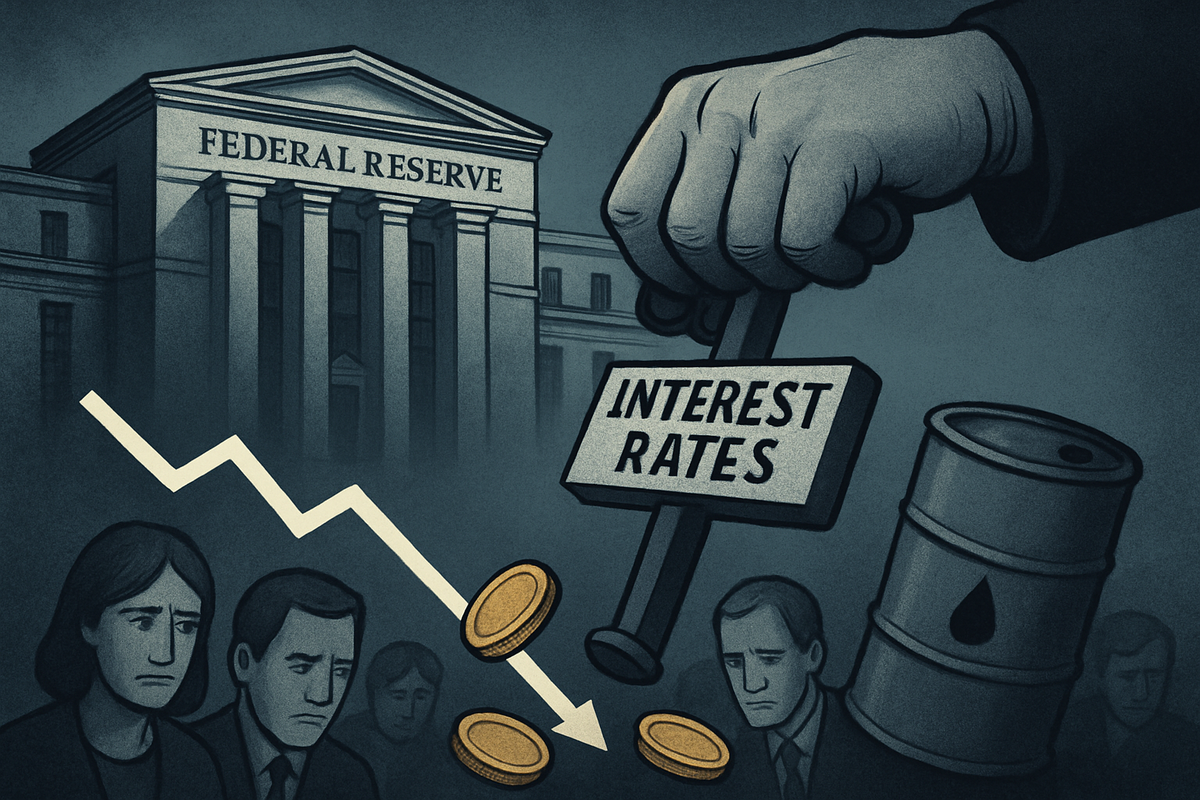
November 14, 2025 – The Federal Reserve's increasingly hawkish rhetoric has cast a significant chill over global investor optimism today, sending a clear signal that a "higher for longer" interest rate environment is firmly on the horizon. Despite recent modest rate cuts in September and October, key Fed officials have adopted a surprisingly resolute tone, effectively dashing market hopes for further aggressive easing and triggering a widespread "risk-off" sentiment across financial markets. This pivot has had immediate and pronounced effects, particularly in the volatile commodity sectors, where prices for precious and industrial metals have seen sharp declines.
The central bank's firm stance, emphasizing persistent inflation concerns and the surprising resilience of the U.S. economy, has prompted a rapid recalibration of market expectations. Investors, who had largely priced in a more accommodative path, are now grappling with the implications of sustained elevated borrowing costs. The resulting apprehension is evident in plummeting equity markets, increased volatility in digital assets, and a notable strengthening of the U.S. dollar, collectively painting a picture of a market bracing for a more restrictive monetary policy future.
Federal Reserve's Unyielding Grip: A Detailed Look at the Hawkish Pivot
The Federal Reserve's shift to a distinctly hawkish monetary policy in November 2025 has been meticulously orchestrated through a series of statements and actions, designed to temper inflation expectations and solidify a restrictive financial environment. Despite implementing a 25 basis point (bp) rate cut in October, following a similar reduction in September, bringing the federal funds rate to a target range of 3.75%-4.00%, the overarching message from the Fed has been anything but dovish.
A pivotal moment came with Chair Jerome Powell's explicit statement that a further rate cut in December was "not a foregone conclusion." This remark alone dramatically altered market probabilities for a December cut, which had been as high as 95% a month prior, now hovering around 48-53% by mid-November. Powell also acknowledged "strongly differing views" among Federal Open Market Committee (FOMC) members, underscoring the internal debate but ultimately signaling a less accommodative path. This sentiment was echoed by a chorus of prominent Federal Reserve officials, including Minneapolis Fed President Neel Kashkari, St. Louis Fed President Alberto Musalem, Cleveland Fed President Beth Hammack, Atlanta Fed President Raphael Bostic, Kansas City Fed President Jeff Schmid, and Boston Fed President Susan Collins. All have voiced concerns about persistent inflation and the unexpected strength of the U.S. economy, with Bostic specifically identifying inflation as a more pressing risk than potential labor market softness. Further solidifying this stance, the Fed announced its decision to conclude the reduction of its aggregate securities holdings on December 1, following a gradual tapering process earlier in the year. The recent U.S. government shutdown, leading to a blackout of crucial economic data like October's inflation and employment reports, has only compounded the uncertainty, with Powell likening the situation to "driving in the fog."
The immediate market reaction has been swift and unforgiving. Investor optimism has been significantly dampened, leading to a broad "risk-off" sentiment. U.S. equities have experienced heavy selling, with the S&P 500 falling more than 1% on multiple occasions, and technology and AI-related stocks leading the decline due to valuation concerns and widespread profit-taking. The nervous shift also rippled through digital assets, with Bitcoin falling to a six-month low as investors shunned speculative trades. While the dollar initially saw some volatility, hawkish Fed comments, particularly from St. Louis Fed President Alberto Musalem regarding limited room for additional cuts, helped it strengthen. Investor confidence in the Eurozone also unexpectedly declined, reflecting the global reach of the Fed's influence.
Commodity markets have borne the brunt of this hawkish turn, facing widespread apprehension and significant declines. Higher interest rates increase the cost of borrowing and the opportunity cost of holding non-yielding assets like commodities, diverting investment capital towards yield-bearing alternatives. Simultaneously, a strengthening U.S. dollar makes dollar-denominated commodities more expensive for international buyers, thereby dampening demand. Precious metals have been particularly hard hit today, November 14, 2025. Gold prices plummeted by Rs 5,000 per 10 grams in India and fell over 3% in general trading, while silver experienced an even steeper fall. Platinum and palladium also registered significant drops, attributed to aggressive profit-taking and reduced safe-haven demand as hopes for interest rate cuts diminished. Industrial metals are similarly experiencing downward pressure. In a notable divergence, crude oil and natural gas have seen recent upticks, primarily driven by geopolitical tensions and weather forecasts, rather than direct Fed policy implications, though Brent crude prices were noted as flat after a significant drop in a preceding session.
Corporate Fortunes Diverge: Winners and Losers in a Falling Commodity Market
The Federal Reserve's hawkish stance, leading to a "higher for longer" interest rate environment and subdued global economic growth, is creating a clear divide between public companies that stand to benefit and those that will face significant headwinds. As commodity prices continue their anticipated decline into late 2025 and early 2026, corporate revenues, profits, and stock performances will reflect their exposure to these volatile markets.
Companies that primarily consume commodities as input costs are poised to emerge as "winners." Manufacturing companies, for instance, are major consumers of energy and metals. Lower raw material costs can significantly improve their profit margins. Apparel manufacturer HanesBrands (NYSE: HBI) and consumer goods giant Clorox (NYSE: CLX) have already indicated that lower input costs could positively impact their operating margins and fiscal year outlooks. The transportation industry, encompassing airlines, trucking, and shipping companies, is highly sensitive to fuel prices. Lower oil prices directly reduce operating expenses, boosting profitability. Furthermore, a decline in freight rates, driven by reduced consumer spending and overcapacity in the shipping industry, benefits businesses relying on these services. Consumer goods companies, particularly producers of staples like food, beverages, and household products, will also benefit from reduced costs for agricultural products and other raw materials. These companies, characterized by inelastic demand for their products, are often considered defensive in an economic downturn. Similarly, construction companies will see reduced transportation costs for materials, equipment, and supplies, leading to lower project costs and enhanced profitability.
Conversely, companies whose core business revolves around the extraction, production, or direct sale of commodities are likely to be "losers" in this environment. Oil & gas producers, such as ConocoPhillips (NYSE: COP), will directly suffer from lower crude oil prices, leading to decreased revenues and profitability. Many in the sector are already reporting reduced earnings and implementing budget tightening measures. Mining companies, producing base metals like iron ore, copper, and aluminum, will also experience declining revenues and profits as prices fall. While long-term trends for "green metals" remain strong due to the energy transition, the immediate outlook is challenging. Agricultural producers, especially those focused on soft commodities like soybeans, may see their revenues and profits negatively impacted by abundant global supply and shifting demand, as evidenced by CHS Inc.'s (NASDAQ: CHSCP) Ag segment performance. Companies holding large commodity inventories also face the risk of writedowns, directly impacting their bottom line.
The overall impact on corporate financials will be stark: commodity producers will see direct revenue and profit declines, while net consumers of commodities are likely to experience improved profit margins and potentially stable or increased revenues if lower prices stimulate demand. Stock performance will mirror these trends, with commodity producers expected to underperform, and companies benefiting from lower input costs likely to see improved valuations as their earnings strengthen.
Broader Implications: Navigating a Shifting Economic Landscape
The Federal Reserve's hawkish posture, coupled with its chilling effect on investor optimism and commodity prices, extends far beyond immediate market reactions, embedding itself within broader industry trends and creating significant ripple effects across the global economy. This period of monetary tightening, reminiscent of historical efforts to quell inflation, carries substantial regulatory and policy implications that will shape the coming years.
This environment is intricately linked to a prevailing global economic slowdown, particularly evident in major economies outside the U.S. While the U.S. economy shows surprising resilience, subdued demand for industrial metals and energy globally is a key driver of falling commodity prices. Simultaneously, the accelerating global energy transition presents a paradoxical trend: while overall commodity indices soften, the demand for critical minerals like copper, silver, and lithium for green technologies ensures their long-term price sensitivity. This creates a bifurcated market where "green metals" may maintain a premium despite broader declines. In the traditional energy sector, an anticipated oversupply in global oil markets for 2025, driven by muted demand and increased non-OPEC+ output, contrasts sharply with projected growth in natural gas demand, fueled by U.S. LNG exports and domestic power generation. Underlying these trends is a heightened emphasis on supply chain resilience and nationalism, as geopolitical tensions compel nations to prioritize energy and food security, potentially leading to further market fragmentation and trade restrictions, such as the U.S. imposition of a 50% tariff on copper imports effective August 2025.
The ripple effects are profound. Companies reliant on inexpensive financing will face higher borrowing costs, potentially slowing industry consolidation and innovation. This tightening of capital markets could also lead to more startup failures, particularly in technology. Emerging markets are particularly vulnerable, as a stronger U.S. dollar typically triggers capital outflows, increases their debt servicing costs for dollar-denominated obligations, and makes dollar-priced imports more expensive. Commodity producers, including mining and refining industries, will grapple with adjustments, renegotiated contracts, and deferred new projects. Conversely, manufacturing and consumer goods sectors will face varying abilities to absorb or pass on raw material costs, potentially leading to shifts in market share and some stabilization of consumer prices.
Regulatory bodies and governments are under immense pressure to navigate these complex currents. Central banks, especially the Federal Reserve, are scrutinizing their credibility while balancing inflation control with economic stability. Other central banks may be compelled to raise interest rates to defend their currencies against a strengthening dollar and combat imported inflation, even if their domestic economies are fragile. Fiscal policy may need to complement monetary tightening, with a growing trend of employing tariffs and other protectionist measures, which, while intended to secure domestic supply, risk further fragmenting global markets. Historically, periods of aggressive monetary tightening by the Fed, such as the Volcker era in the early 1980s, were aimed at quelling rampant inflation and often preceded economic slowdowns. More recent tightening cycles, like those leading up to the 2008 financial crisis and the hikes from 2022-2023, also saw significant corrections in commodity markets, underscoring the delicate balance central banks must strike.
The Road Ahead: Navigating Uncertainty and Emerging Opportunities
As the Federal Reserve entrenches its hawkish stance and commodity markets recalibrate, the period following November 2025 is poised for continued shifts, presenting both formidable challenges and distinct opportunities for businesses and investors. The "higher for longer" interest rate paradigm is expected to persist, shaping short-term market dynamics and long-term strategic adaptations.
In the short term, the market will likely remain volatile, with investor sentiment dampened by the delayed prospects of aggressive rate cuts. While the U.S. economy is anticipated to exhibit positive but limited growth (1.5% to 2% annualized), global growth may face greater challenges, with a projected return to a trend-like 3% pace in 2026. U.S. inflation is expected to remain above the Fed's 2% target, potentially accelerating in 2026 due to factors like tariffs. Commodity prices, in aggregate, are forecast to moderate or decline further into early 2026, with the S&P Goldman Sachs Commodity Index potentially declining by 1.3% in 2025 and 1.4% in 2026. However, a bifurcated market is likely, with precious metals (gold, silver, platinum) and natural gas potentially outperforming due to safe-haven demand and strong export flows, while crude oil, agricultural commodities, and industrial metals face headwinds.
Looking further out, into 2026 and beyond, the Federal Reserve's policy rate might eventually settle around 3%, with inflation expected to remain above 2% until 2028. Global growth is projected to stabilize, but structural tensions like high deficits and geopolitical uncertainty will continue to weigh on corporate investment. Aggregate commodity prices are expected to stabilize by mid-2026 and begin recovering into 2027 as global activity improves, potentially aided by a weakening U.S. dollar. Persistent inflationary pressures from trade tariffs could also shape the long-term outlook.
Companies must embrace agility and strategic adaptation. This includes focusing on operational efficiency, resource recycling, and strengthening supply chain resilience to navigate rapidly shifting demand patterns and geopolitical disruptions. Robust risk management strategies for forecasting and hedging against commodity price volatility will be critical. Many CEOs, facing uncertainty, have delayed investment decisions, highlighting the need to re-evaluate long-term commitments. Cost management and hiring freezes are likely to become more prevalent, with a growing adoption of AI to drive revenue with leaner headcounts, potentially contributing to structurally higher unemployment.
Market opportunities will emerge amidst these challenges. Value investing in fundamentally strong companies and the financial sector may see improved profitability. Energy-importing economies could benefit from lower commodity prices. High-quality fixed income, including agency mortgage-backed securities and senior structured credit, offers attractive yields, with some contrarian investors eyeing long-dated Treasuries. Strategic investments in renewable energy infrastructure, critical mineral extraction, and advanced natural gas technologies are also poised for growth. A healthy market rotation from expensive growth stocks, particularly in technology and AI, towards more reasonably valued sectors like industrials, financials, energy, and healthcare is anticipated. Challenges, however, include the risk of a global economic slowdown, continued credit tightening, market volatility, and the persistent specter of geopolitical and trade uncertainty.
Potential scenarios range from a "higher for longer" base case extending into early 2026, to a "soft landing" with modest global GDP growth. There's also the risk of a persistent inflationary environment, requiring the Fed to maintain a tighter policy. A significant market correction, particularly in overvalued tech stocks, could lead to a healthy rebalancing. The "bifurcated market" for commodities will likely continue, with divergent performance across sectors. The risk of policy error, particularly cutting rates "too far too fast," is rising, which could lead to sharply steeper yield curves. Political influences, such as potential tariff unwinding if inflation drops, could also significantly impact market dynamics.
Concluding Thoughts: A Market in Transition
The Federal Reserve's unwavering hawkish stance, a defining characteristic of the financial landscape in November 2025, has unequivocally dampened investor optimism and triggered a significant downturn across many commodity markets. This pivot, driven by persistent inflation and a surprisingly resilient U.S. economy, marks a crucial transitional phase for the global market, moving away from an era of readily available cheap capital towards a sustained period of higher interest rates.
The key takeaway is a clear divergence between market expectations and the Fed's resolve. While investors had hoped for a more aggressive easing cycle, the central bank's communication signals a shallower path of rate reductions, leading to a "higher for longer" outlook. This has directly impacted commodity prices, with precious metals like gold and silver tumbling due to increased opportunity costs and a strengthening U.S. dollar. The market is now grappling with the implications of sustained elevated borrowing costs, which are reshaping investment valuations and capital allocation strategies.
Moving forward, the market will remain in flux. While some experts anticipate moderate rate cuts into early 2026, the Fed's own projections suggest a federal funds rate significantly higher than what traders had priced in. Equities are expected to navigate continued volatility, though robust corporate earnings and tailwinds from artificial intelligence (AI) could offer support, particularly for large-cap U.S. companies. Bonds, especially in the short-to-intermediate space and selective credit exposure, may become more attractive as cash yields potentially fall. Commodity markets will likely remain bifurcated, with natural gas and precious metals possibly outperforming, while oil and base metals face continued pressure.
The lasting impact of this period of prolonged hawkishness could be a "stagflation-light" scenario, where inflation remains elevated while economic growth moderates. Globally, it risks limiting credit availability, particularly for developing markets, and could hinder the transition away from fossil fuels, exacerbating climate inequities.
Investors in the coming months should meticulously monitor several critical factors:
- Fed Communications and "Dot Plot": Closely track FOMC statements, speeches by Fed officials, and updated Summary of Economic Projections (the "dot plot") for clues on the pace and magnitude of future rate cuts.
- Economic Data: Pay keen attention to upcoming economic data releases, especially those delayed by the recent government shutdown, focusing on labor market health (unemployment rate, job growth), inflation trends (CPI, PCE), and consumer spending.
- Tariff Policies: The impact of tariffs on inflation and investment spending remains a significant concern.
- Corporate Earnings: Continue to watch corporate earnings reports, particularly from large-cap U.S. companies and the technology sector, for signs of resilience.
- Geopolitical Developments: Geopolitical tensions will remain a key driver, especially for safe-haven assets like gold.
- Market Expectations vs. Fed Projections: The ongoing divergence between market pricing for rate cuts and the Fed's signals will continue to be a source of volatility.
The coming months will be crucial for investors to assess whether the recent market pullback signifies a temporary correction or the inception of a more protracted adjustment to the Federal Reserve's sustained hawkish stance.
This content is intended for informational purposes only and is not financial advice






